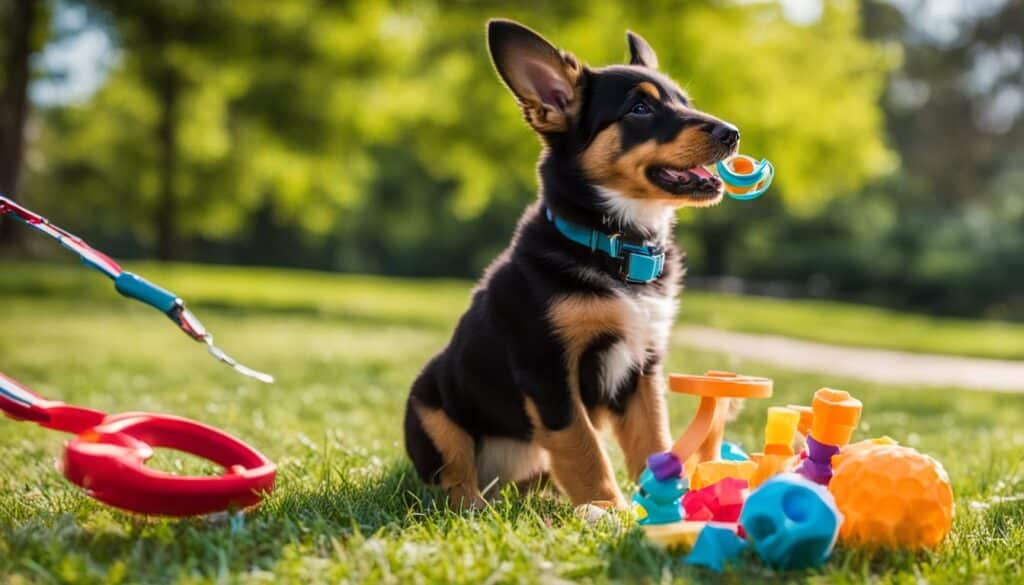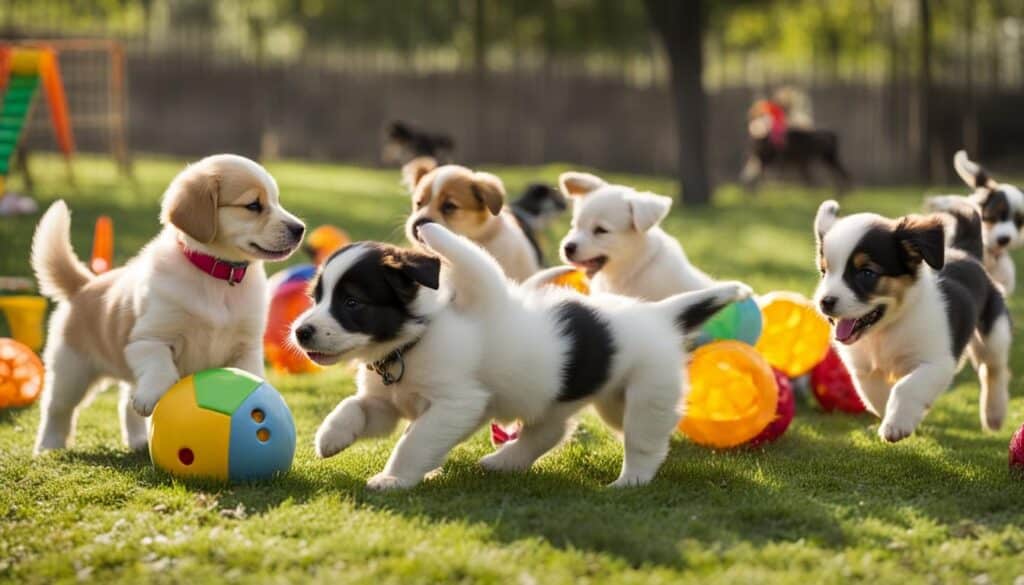Troubleshooting common puppy training challenges can be daunting for new dog owners. From housebreaking to chewing to obedience,there are a variety of issues that can arise during the training process. Fortunately, some expert tips and strategies can help address and overcome these challenges. In this article, we will explore the most common puppy training challenges and provide expert guidance on troubleshooting and tackling them effectively.

Key Takeaways:
- Puppy training challenges are common and can be resolved with expert tips.
- Housebreaking, chewing, and obedience are common challenges faced during puppy training.
- Expert guidance is essential in troubleshooting these challenges effectively.
- Understanding the root causes helps address jumping behavior, recall reliability, and leash pulling.
- Consistency and early intervention are crucial for successful puppy training.
Tackling the Big Three: Jumping, Ignoring Recall, and Leash Pulling
Jumping, ignoring recall, and leash pulling are three of puppy owners’ most common challenges. This section will delve into the root causes of jumping behavior, why puppies don’t always come when called, and strategies for preventing leash pulling and promoting polite walking. By understanding the reasons behind these behaviors and implementing effective training techniques, you can address these issues and create a well-behaved and obedient puppy.
Understanding the Root Causes of Jumping Behavior
Jumping is a natural behavior for puppies but can become problematic when directed at people. Understanding the root causes of jumping behavior is crucial for addressing this challenge. Puppies jump to greet their owners, seek attention, or display excitement. It’s important to discourage jumping by teaching alternative behaviors, such as sitting or offering a paw. Consistent training and positive reinforcement can help redirect your puppy’s jumping behavior and establish polite greetings.
Recall Reliability: Why Puppies Don’t Always Come When Called
Recall reliability, or the ability to come when called, is essential for every puppy. However, many puppies struggle with this command, leading to frustration for owners. It’s critical to understand why puppies only sometimes come when called. Disturbances, lack of training, and fear can contribute to unreliable recall. By using positive reinforcement training methods, creating a positive association with the recall command, and gradually increasing distractions, you can improve your puppy’s recall reliability and ensure their safety.
Preventing Leash Pulling: Strategies for Polite Walking
Leash pulling can turn a peaceful walk into a frustrating experience. Teaching your puppy to walk politely on a leash is essential for enjoyable walks. Understanding the strategies for preventing leash pulling can make a significant difference. It’s necessary to use positive reinforcement techniques such as rewards and praise, proper leash handling, and consistent training. By rewarding your puppy for walking beside you and providing clear communication, you can establish polite walking behavior and make walking more enjoyable for you and your furry companion.
Creating Consistency: The Key to Effective Puppy Training
Creating consistency is crucial when it comes to practical puppy training. Dogs thrive on routine and clear expectations, so consistency in your training methods and strategies is essential. By being consistent with your training, you can ensure that your puppy understands and learns the desired behaviors more efficiently.
Consistency in puppy training means establishing rules and expectations that you consistently reinforce. This includes using the same commands, gestures, and rewards every time you train your puppy. Whether working on basic obedience commands or addressing specific behavioral issues, sticking to a consistent approach will help your puppy understand what you expect from them.
Training strategies can vary depending on the individual puppy and the goals you want to achieve. However, there are a few fundamental principles of consistency that apply universally:
- Set a regular training schedule: Consistency starts with setting a regular training schedule. Dedicate specific times to work with your puppy each day, focusing on short, focused training sessions. This helps your puppy learn to anticipate and engage in training activities, making the learning process more effective.
- Use consistent cues and commands: Choose a set of cues and commands for each behavior or command you wish to teach your puppy and stick to them. Consistently using the exact words and gestures helps your puppy understand what is expected of them. For example, if you’re teaching your puppy to sit, consistently use the word “sit” with a distinct hand gesture.
- Reinforce desired behaviors consistently: Provide consistent reinforcement when your puppy demonstrates the desired behavior. This can include verbal praise, treats, toys, or any other reward that motivates your puppy. Using the same rewards consistently helps your puppy understand that they are being rewarded for the correct behavior and reinforces their understanding of what you expect.
- Keep training sessions consistent and focused: During training sessions, maintain a consistent and concentrated environment. Minimize distractions and ensure that your puppy is in the right frame of mind for learning. Keeping the training environment consistent helps your puppy stay engaged and reduces confusion.
- Be consistent with your expectations: Consistency also means holding your puppy to the same standards of behavior every time. Don’t let your puppy get away with behaviors you don’t want to encourage. Set clear boundaries and consistently enforce them, helping your puppy understand what is acceptable and what is not.
By establishing and maintaining consistency in your puppy training, you can set your furry friend up for success. Remember, consistency is not only crucial during training sessions but also in your everyday interactions with your puppy. By being consistent in your approach, you’ll build a strong foundation of training and create a well-behaved and obedient puppy.

Early Intervention: Training Your Puppy Before Problems Arise
Early intervention is crucial when it comes to puppy training. Training at a young age can lay the foundation for good behavior and prevent undesirable habits from forming. This section will explore the benefits of early intervention and discuss the essential foundation skills that every new puppy should be taught.
The Benefits of Starting Training at a Young Age
Training your puppy at a young age offers numerous advantages. Here are some key benefits:
- Behavior Development: Starting early allows you to shape your puppy’s behavior and establish positive habits.
- Bonding: Training sessions provide an opportunity for you and your puppy to bond and develop a strong relationship based on trust and communication.
- Socialization: Early training exposes your puppy to different environments, people, and other animals, which helps them become well-adjusted and friendly.
- Confidence Building: Training gives your puppy confidence, helping them navigate new experiences with ease and reduced anxiety.
Foundation Skills to Teach Your New Puppy
When training a new puppy, focusing on foundation skills is essential. These skills serve as building blocks for more advanced training. Here are some critical foundation skills to teach your puppy:
- Name Recognition: Teach your puppy to respond to their name, establishing a basis for communication and attention.
- Sit: Teaching your puppy to sit on command is a fundamental skill that promotes impulse control.
- Come: Train your puppy to come when called, ensuring their safety and your ability to control their behavior.
- Stay: Teach your puppy to stay in one place until released, promoting self-control and focus.
- Leash Walking: Train your puppy to walk politely on a leash, making walks enjoyable and peaceful for both of you.
- Potty Training: Establish a routine and teach your puppy where and when to eliminate, promoting good hygiene habits.
By focusing on these foundation skills, you can set your puppy up for success and create a solid training framework for the future.

Training Techniques: Positive Reinforcement and Patience
When it comes to troubleshooting common puppy training challenges, effective training techniques are paramount. Two critical elements in successful training are positive reinforcement and patience. In this section, we will explore how to harness the power of these techniques to address and overcome training obstacles with your furry companion.
How to Use Treats and Rewards Correctly
Treats and rewards are one of the most potent tools in puppy training. They can motivate your puppy to learn and reinforce positive behaviors when used correctly. Here are some tips on how to use treats and rewards effectively:
- Choose high-value treats for your puppy – ones that they find particularly enticing and rewarding.
- Use small, bite-sized treats to minimize distractions and ensure quick consumption.
- Timing is critical – reward your puppy immediately after they perform the desired behavior to reinforce the connection between the action and the reward.
- Gradually reduce the frequency of treats as your puppy becomes proficient in the behavior, transitioning progressively to intermittent rewards.
- Remember to praise and give verbal encouragement along with the treats to reinforce positive reinforcement.
Establishing Training Sessions That Set Your Puppy Up for Success
Training sessions are crucial for your puppy’s development but must be structured and designed for success. By implementing the following strategies, you can create training sessions that maximize learning:
- Keep training sessions short and frequent, as puppies have shorter attention spans.
- Choose a quiet environment without distractions to minimize interruptions.
- Break training tasks into smaller, manageable steps to prevent overwhelming your puppy.
- Use consistent commands and cues to help your puppy understand what is expected of them.
- End each training session positively, celebrating your puppy’s achievements and progress.
When and How to Seek Professional Help with Training
While many puppy training challenges can be addressed independently, there are instances where it’s essential to seek professional help. Professional trainers have the expertise and experience to handle more complex training issues. Here are some signs that it may be time to seek professional help:
- There needs to be more progress despite your utmost efforts and consistent training.
- Aggressive or fearful behavior that poses a risk to you, your puppy, or others.
- Severe separation anxiety or destructive behavior that cannot be managed.
- Need to address specific obedience or behavior problems.
When seeking professional help, ensure you choose a certified dog trainer or behaviorist who uses positive reinforcement techniques and has a good reputation.
By implementing positive reinforcement techniques, using treats and rewards effectively, establishing successful training sessions, and seeking professional help, you can confidently address common puppy training challenges and navigate the training process. With patience and persistence, you will build a strong bond with your puppy and lay the foundation for a well-behaved and obedient companion.
Conclusion: Troubleshooting Common Puppy Training Challenges
Troubleshooting common puppy training challenges requires understanding, patience, and practical techniques. Throughout this article, you have learned expert tips and strategies to help you overcome these common issues. Applying these tips and techniques can establish a strong training foundation for your puppy and create a well-behaved and obedient furry friend.
Consistency and persistence are essential for successful training. You can tackle any challenge that arises by maintaining a consistent approach to training and persistently working with your puppy. Remember to be patient with your pups as they learn and grow.
By utilizing positive reinforcement techniques, such as using treats and rewards correctly and establishing successful training sessions, you can motivate your puppy to learn and reinforce desired behaviors. However, if you need help with training or facing more complex challenges, seek professional help.
A professional dog trainer can provide customized guidance and support to address specific training issues.In conclusion, with the expert tips and strategies outlined in this article, you can troubleshoot common puppy training challenges and pave the way for a well-behaved and obedient companion.
By understanding the root causes of behavior issues, creating consistency in your training, starting early with your puppy’s training, and utilizing positive reinforcement techniques, you can overcome obstacles and build a strong bond with your furry friend.
FAQ
What are some common puppy training challenges?
Some common puppy training challenges include housebreaking, chewing, and obedience issues.
How can I address jumping behavior in my puppy?
Understanding the root causes of jumping behavior and implementing proper training techniques can help address and discourage this behavior in your puppy.
Why doesn’t my puppy always come when called?
Recall reliability can be improved by understanding its reasons and using effective training strategies to reinforce the behavior of coming when called.
How can I prevent leash pulling during walks?
Strategies like positive reinforcement and consistent training can help prevent leash pulling and promote polite walking in your puppy.
Why is consistency important in puppy training?
Consistency is crucial in establishing clear expectations and routines for your puppy, which helps them understand what behaviors are desired and reinforces the training process.
When should I start training my puppy?
It is recommended to start training your puppy at a young age to lay the foundation for good behavior and prevent undesirable habits from forming.
What are some essential foundation skills to teach a new puppy?
Some essential foundation skills to teach your new puppy include potty training, basic obedience commands, and socialization with other dogs and people.
How do I use treats and rewards correctly in puppy training?
Using treats and rewards as positive reinforcement can motivate your puppy and encourage the desired behavior during training sessions.
How can I establish successful training sessions with my puppy?
Establishing a consistent training routine, using positive reinforcement techniques, and keeping sessions short and engaging can lead to successful training sessions with your puppy.
When should I seek professional help with puppy training?
If you are struggling to address common puppy training challenges or if your puppy’s behavior is causing significant issues, seeking professional help from a qualified dog trainer may be beneficial.


Thanks for sharing. I read many of your blog posts, cool, your blog is very good.